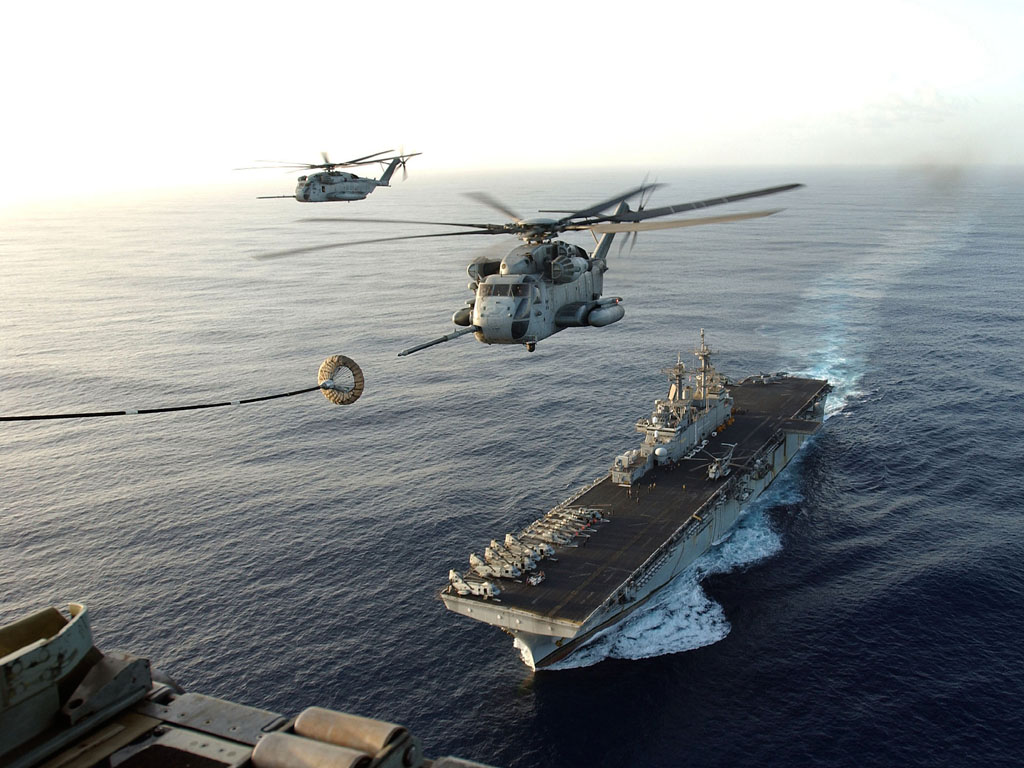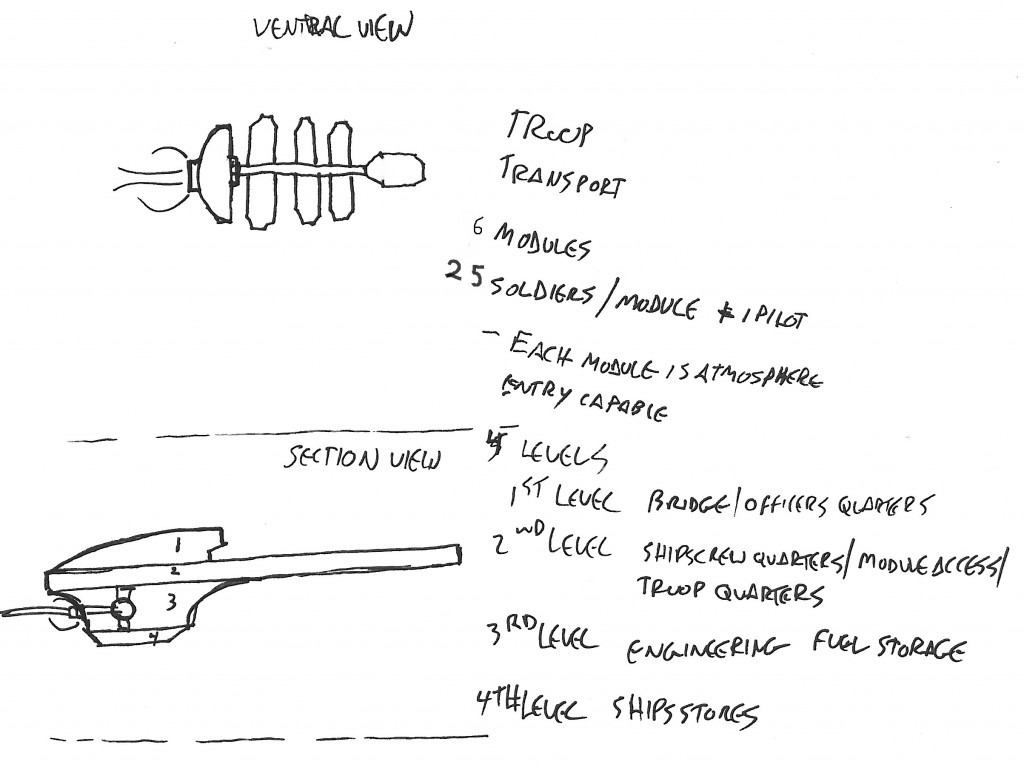When I was 7-ish I walked into the living room where dad was watching a show about space ships, guys in primary colors and aliens, “What’s this?” “Star Trek, it’s about space.” he said, between the dialog. I sat down next to him quietly, completely transfixed, I remember, at the time, feeling really special that he’d share this with me. I’ve been pretty lucky with my parents: Mom gave me my love of all things Fantasy and from dad, Science Fiction. Because of him I’ve always loved drawing starships; exteriors, interiors, odd angles, you name it I’ve put it on paper somewhere. I’d like to share with all of you my process of creating a starship deck plan and elevation cross section, from the initial idea of the pen and ink sketch to the final completed render. I’ll be documenting the good and the bad (and the design dead-ends) with the hope that it inspires others to share their designs as well.
A science fiction cornerstone for any grand space opera, is a well-designed and believable vehicle for your PCs. A good ship design should get an emotional reaction from everyone who sees it.  If some minor planning takes place during the early stages of the design, your players will treat it like another character they encounter in their game: love it, hate it, mourn it when it’s gone. If you ignore a setting where your characters will spend a good portion of their campaign you risk the worst reaction of all: indifference.
If some minor planning takes place during the early stages of the design, your players will treat it like another character they encounter in their game: love it, hate it, mourn it when it’s gone. If you ignore a setting where your characters will spend a good portion of their campaign you risk the worst reaction of all: indifference.
Like every NPC, a well designed ship should (figuratively and literally) propel the plot forward while serving as a hub and safe haven; a place your players can catch their breaths and decide what action to take next. But, it should also fit into the story as well: Do you have a galaxy spanning mystery and need the best and brightest to solve it? A ship that encompasses human knowledge and understanding and aids its crew in accomplishing the mission at hand, like the Enterprise, fits the need nicely. What if your players discovered some unspeakable evil and a vehicle is needed to intensify the isolation and paranoia as they try and survive? The Ishimura (Dead Space) or Nostromo (Alien) are great examples of a design that works against the goals of its passengers. In the end, creating a good back story for your starship is as equally important as deciding where the engine and bridge belong.
What’s the need?
When it comes to designing a starship there are 3 basic roles that can describe any ship type you’ll need in your campaign:
1. Ships that carry stuff/people/aliens
2. Ships that look for stuff/people/aliens
3. Ships that want to blow-up stuff/people/aliens
That’s not to say you can’t have a ship that does more than one role (like a spaceship that looks for stuff and blows up stuff) but, by focusing on a single role in the beginning your boat design will be easier to flesh-out. If you look at any modern naval ship, for a contemporary example, you’ll find that these three roles are often mixed; the United States’ Navy’s Wasp class amphibious assault ship performs each of these roles very well:
Move a lot of Marines into battle, quickly (carry people)
It’s a small(ish) aircraft carrier (blow up people/stuff)
Support search and rescue/humanitarian missions (look for stuff)
The original design goal, get Marines on the beach quickly and once there support them so they don’t get killed, defines the need; the secondary roles it.
The first question you should ask yourself is: What will I need this ship to do? I’ve posted some small ships on the forum that already cover the look for stuff / blow up stuff roles and now, for this post I want to try a smaller carry people role troop transport…
What’s the story?
The next step is filling in the back-story of your ship, and this can be as detailed or as sparse as you need and want. Since I know I’ll be designing and building a troop transport, I now have to ask: How will it do that?
The idea of a large box packed full of soldiers slowly de-orbiting and dodging anti-aircraft fire seems to me, representative of a WWI mindset (Just keep charging that trench, boys! Eventually their trigger fingers will cramp, then we got ‘em!). Once again, this is not a bad idea; it’s just not how I want to design this ship. I want a ship that’s more nimble, marginally concerned with passenger comfort and safety, and if some damage is taken, not doom everyone.
I’ll also need to consider how many troops will be carried on board, once I decide this, filling out the remaining ship’s crew will be easier. Since I’ve decided to make this a smaller, company sized, troop carrier (about 140 soldiers) I’ll need to determine how to get them to the battle field.
 The final piece of this initial puzzle and the ship I’ll be designing is one that will get the drop ships to where they need to be. The (very rough) sketch to the left shows all the major details of the troop carrier, plus a few detail notes. This drawing shows a four level transport with six drop ships that attach to it along a central corridor.
The final piece of this initial puzzle and the ship I’ll be designing is one that will get the drop ships to where they need to be. The (very rough) sketch to the left shows all the major details of the troop carrier, plus a few detail notes. This drawing shows a four level transport with six drop ships that attach to it along a central corridor.
I like the image of fast entry orbital drop ships leaving trails of super-heated plasma as they tear through the sky, when they get to their LZ, anti-gravity engines kick in slowing their descent, the troops rushing out to meet their fates when they touch down.
I want to avoid the look of a modern aircraft carrier or the BSG, where ships are parked in an enormous internal hanger. If things get bad during an insertion and the hull is breached,… well, all hands lost. Part 2 will have us transfer the drawing into Cosmographer 3 and start to place points of interest like command and control, engineering, and living and work spaces.
Keep Calm
and
Map On
[…] […]